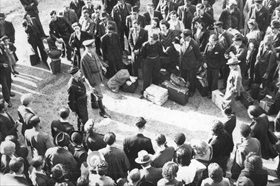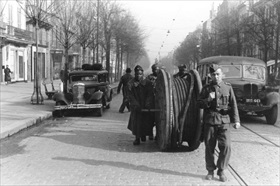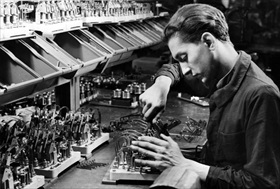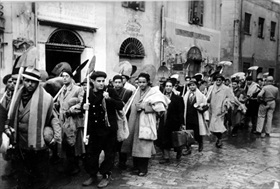VICHY ENACTS LAW LEADING TO REQUIRED WORK SERVICE
Vichy, France • September 4, 1942
Because so many young German men were needed on Germany’s Eastern Front to engage the Soviet Army, Adolf Hitler, toward the end of spring 1942, insisted that the French collaborationist government of Philippe Pétain, whose capital was in the central France town of Vichy, assign some 350,000 French workers to fill the gap in the labor supply available in Germany. On June 22, 1942, Vichy prime minister Pierre Laval announced the enactment of the relève, whereby French workers were encouraged to volunteer to work in Germany to secure the release of upwards of 1.6 million French soldiers (a kind of personnel swap) who were captured in the Battle of France (May–June 1940), and who were held in POW camps in Germany and Eastern Europe or worked in German-run factories, mines, or on farms. Only about 17,000 French workers, mostly unemployed laborers and not the technically skilled workers Nazi Germany needed to conduct its war against the Allied powers (principally the U.S., Great Britain, and the Soviet Union), had signed up by August 1942, despite times being hard.
And so on this date, September 4, 1942, Pétain and Prime Minister Laval signed off on the “loi du 4 septembre 1942 relative à l’utilisation et à l’orientation de la main-d’œuvre,” or “Law of 4 September on the use and guidance of the workforce.” The legislation led to the establishment in February 1943 of the Service du travail obligatoire (compulsory labor service), or STO as it was commonly referred to. The STO was a national draft, applicable to German-occupied France in the north and west of the country as well as the unoccupied Free Zone (Vichy France). Every French male aged 18 to 50 and every unmarried woman aged 21 to 35 was required to give 2 years’ service to work in either Germany or France as a substitute for service in the military. There was a mad scramble for deferments: women sought marriage partners, young men joined the police force or looked for work on the railroad or in mines. Still, roughly 600,000 to 650,000 Frenchmen wound up working in Greater Germany (Germany, Austria, parts of Poland and Czechoslovakia) between June 1942 and July 1944. French employers were outraged at being deprived of so many skilled workers. One million French workers remained in France, working in factories in the service of Germany, either willingly or as forced labor. After the Soviet Union and Poland, France was Germany’s largest forced labor provider, delivering the Nazis the largest number of skilled workers. Some 250,000 French POWs were also forced to work for the Reich from 1943 onwards, having been “reclassified” as civilian workers.
It is unclear how many French POWs were repatriated under the relève requisitions of June 1942 and the later STO compulsory labor levies (probably few) except to say that by August–September 1944 nearly 600,000 French POWs had been reclassified by the Germans as Zwangsarbeiter (forced laborers) along with 654,782 French civilians. What is clear is that Vichy labor legislation undermined the legitimacy of Pétain’s collaborationist regime and increased active resistance to the German occupiers. Many families schemed to prevent their members affected by French law and the general census of French workers from being identified as eligible workers. The French Protestant church boldly asserted that there was an “insurmountable” contradiction between the Gospels and forced labor. French bishops and archbishops met in conference and declared it was not a sin to evade the STO. A significant number of young people who dodged the STO joined the maquis, quasi-guerrilla groups that grew into a powerful force to harass Vichy and German authorities in 1943 and 1944. In Paris alone, the school population fell from nearly 200,000 in 1938–1939 to about 50,000 in the spring of 1944. STO conscripts also formed the first among 35,000 Frenchmen who escaped from France to North Africa to join the Free French, Charles de Gaulle’s government-in-exile, and the French Army of Liberation (L’Armée française de la Libération), which landed with the Allies in Normandy (Operation Overlord) and Southern France (Operation Dragoon) to expel the Germans from all of France in 1944 and defeat Hitler’s Germany in 1945.
French Forced Labor in France and Germany, 1942–1945
 |  |
Left: German and Vichy French officers stand in the middle of a group of Parisians, luggage at the ready, as they await transport in June 1942 to armaments factories in Germany. Between March 1942 and the end of the war 400,000 French volunteers and another 650,000 French men and women who were forcibly sent east worked in German-run factories, mines, shipyards, public utilities, and on farms. Most returned to France after the war (many were treated as traitors in 1945), but many perished abroad, killed in Allied bombing raids or succumbed to malnutrition and exhaustion at their worksites. In all, 3 million Frenchmen, including 1 million POWs, worked for the German war machine, in Germany or in France, either willingly or forced.
![]()
Right: Under German guard French colonial prisoners roll a huge spool of cable through streets in an unnamed city in southern France. Photo dated 1942 and captioned in German: “Französische Kriegsgefangene bei Zwangsarbeit” (forced labor).
 |  |
Left: A young French mechanic (Mechaniker) fulfills his compulsory labor service (zwangsverpflichtete Arbeit) in this Siemens photograph taken in 1943 at one of their armaments factories in Berlin. Albert Speer (pronounced “spare”), Reich Minister of Armaments and War Production for Nazi Germany, agreed with the conclusion of the Vichy government that keeping French workers in France producing for the German war economy would minimize the number of young men heading for the hills to avoid being sent to Germany. Hilter approved Vichy’s and Speer’s request to grant immunity from conscription levies for French men and women already employed in French enterprises producing goods for the German war effort.
![]()
Right: In this photo taken in Tunis, French North Africa, in December 1942, just after the German occupation of Southern France (i.e., Pétain’s Vichy France), Jewish males are seen being rounded up and placed in work details (zur Arbeitsleistung herangezogen).
Prisoners of War, Volunteer Workers, and the STO, Service du Travail Obligatoire (short clip in French)
![]()

 History buffs, there is good news! The Daily Chronicles of World War II is now available as an ebook for $4.99 on Amazon.com. Containing a year’s worth of dated entries from this website, the ebook brings the story of this tumultuous era to life in a compelling, authoritative, and succinct manner. Featuring inventive navigation aids, the ebook enables readers to instantly move forward or backward by month and date to different dated entries. Simple and elegant! Click
History buffs, there is good news! The Daily Chronicles of World War II is now available as an ebook for $4.99 on Amazon.com. Containing a year’s worth of dated entries from this website, the ebook brings the story of this tumultuous era to life in a compelling, authoritative, and succinct manner. Featuring inventive navigation aids, the ebook enables readers to instantly move forward or backward by month and date to different dated entries. Simple and elegant! Click 











